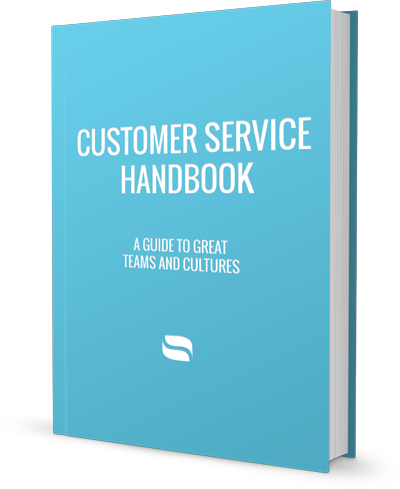







Delivering Awesomeness
This is a part of a continuing series that is also available as a downloadable eBook here. We talked to 35 companies, including Stripe, Twilio, and Mailgun, to get a sense of what it takes to run a great customer support organization. While every company is different, there were some trends that we could identify as benchmarks for great customer support.
Be sure to read what our friends at Zapier had to say after reading this chapter! You can find Wade's comments at the bottom of the page.
The See-Through Culture
The counterintuitive aspect of transparency is how so much of it is not something you can simply just "implement". You cannot only decide to be transparent to your teammates or your friends. Similarly, you cannot simply choose to transparent to your customers. Building a see-through culture takes time, purpose, discipline, and accountability. This means you'll need to find a long term process that is not only agreeable for everyone on your team but one that is also applicable to other businesses processes beyond just customer support. Transparency is a long term strategy.
- Be transparent about who you are.
- Be transparent about what you represent.
- Be transparent about what you can help with and what you can't. Learning to say no to customers can be just as important as anything else.
- Be transparent about what you know or don't know.
- Be transparent about how you will help.
- Be transparent about your processes for customer support and how they apply to customers.
- Be transparent about your faults. You'll soon realize that customers value transparency far more than being pissed off at your faults.
- Be transparent about features, services, pricing, etc.
Transparency sets customers' expectations and can be a huge operating advantage in the long run. When you have a track record for being transparent, customers trust you to tell them exactly what you're thinking, how you've planned to solve their problem, or why you might not be able to. Presenting transparency as a limit, or extent, to which your customer support team will help customers establishes a range in their mind for your service levels.
Jason @ Twilio
"As far as transparency, we try to be honest and up front as early as possible. No shenanigans. No ambiguities. No confusions. What you see is what you get. For service interruptions, we are as transparent as possible. We never want customers to notice a problem or an interruption before we do. When we're having a problem that impacts customers, we notify customers immediately. From there, if they have questions, they can contact us and we'll give them more information about how it impacts them specifically. If it does impact them, we reach out proactively. As we update the status board, we notify customers actively to alert them that service has been restored. We follow up with as much information as we can to prevent things from happening again."
More than just honesty and aligning expectations, transparency is also about getting your real self out there. The general gist of transparency is to open up - open kimono style. Involving your customers in everything you do will settle any uncertainties they might have now or in the future.
Christie @ Outright
"I encourage individuality to show through. But at the same time, I emphasize the need for a consistent tone. Our message can show that we're in t-shirts and jeans and not suits and ties."
Encourage your support staff to be free thinking and creative about how to present themselves and how to solve problems transparently. They'll enjoy conversing with customers a lot more and customers will enjoy them a lot more.
Courtney @ Eventbrite
"Transparency is a part of making sure we're setting clear expectations within the frame of our conversations. If someone contacts us looking for something we don't offer, we can think of workaround, and we'll offer them our thoughts, but we also try to understand why they're looking for a certain feature."
On Accountability
Most of you probably see accountability as an internal phenomenon where employees are held accountable for their actions. There are many different variations on the term "accountability", things such as rewarding accountability, the bottom up approach, the top-down approach, and whatever else you can think of. Accountability isn't about punishments, rewards, making excuses, pointing fingers, or accepting responsibility after-the-fact.
Accountability is an exercise in fact finding. This notion is even more important in a customer support context where mistakes are commonplace. Ideas such as rewarding employees for being accountable influence your support agents to become overly conservative in their actions, complacent in their attitudes, and overly compromising in their quality of work.
Jason @ Twilio
"We have a goal as a team but I don't hold each individual over their heads. We look at everything from the team perspective. From a philosophical perspective, I feel that putting a lot of individual metrics on the people is counterproductive for a support team. We need people to work together as a unit as opposed to individual competition between folks. We don't focus on other things and we don't hold them accountable for their day-to-day performance."
Framing accountability as a method for future proofing is far more productive. If something goes wrong, the question being asked should be how we systematically failed, how the process failed, and how to avoid such mistakes in the future. Seeing accountability through this lens frees up mindshare and filters it down to its essence: the willingness, the desire, and the ability to demonstrate care for customers.
Courtney @ Eventbrite
"It's also important for new hires to understand just how much trust and accountability we place in them. At the end of the day, we trust each person to make the best judgment call based on the information they've gathered to provide the best experience possible for the customer."
And since you're unlikely to hire uninspired, unwilling, and undesirable people in the first place, how do you sustain a healthy level of willingness and desire in your customer support team?
- Encourage mistakes. The more mistakes they make, the faster they learn. They'll run out of mistakes sooner or later.
- When mistakes are made, admit them.
- No bottom-up approach or top-down approach. Treat everyone the same.
- If you're going to trust someone to talk to customers, trust them 100%.
- Value those who ask questions, those who become genuinely concerned, those who get excited about the little things, and those who challenge you.
Christie @ Outright
"I look for teammates to be accountable to each other on the team level rather than the individual level. This makes everyone work together better."
Lauren @ Twice
"My passion for ensuring the best for our customers is shared by the rest of the team and we're always very focused on our customers' needs. Every week, I share an report internally with the entire office, which includes a breakdown of customer service activities, issues we need to work on, and what we're doing well. When I find trends relevant to customer returns, or increases in customer requests for additional features to be built out, everyone in the office will know about it. We're very transparent about what's going on in our respective departments and we make it a point to share both successes and challenges so that we can help each other out."
Respond Fast
Customers love it when you reply fast. It's no doubt we're all spoiled by the swiftness in which we can obtain information. Having customers who are willing to wait is truly a luxury. You need to adapt to this. That 24 to 48 hours timeframe is so 2001. At Reamaze, we employ a "see it – take it" approach for customer support. As long as we're not busy with something else, we're getting back to customers on-the-fly (usually within 5-10 minutes for a first response and 30-60 minutes for a follow up response). Heck, we don't even use an autoresponder during business hours unless we expect specific spikes in inquiries.
Taylor @ Mailgun
"Basically, they just want someone to acknowledge them and provide quality feedback in a timely manner. Even if it's not the feedback they are looking for, they respect well reasoned responses."
Put yourself in customers' shoes. Reaching out for support creates anxiety! And waiting for your answer or acknowledgement over the course of 24 to 48 hours creates even more anxiety and frustration that might make them change their minds about you.
- Even if you might not have a solution right away, strive to send a personal comment to the customer to alert them that you are human and that you are working on answering the question.
- Being swift with "On-Call" responsiveness can reduce a customer's anxiety significantly. They immediately understand that they're in good hands, that the company is active and present, and that they can trust you.
- By eliminating potential anxiety, negative attitudes can often be subdued or counterbalanced.
- Give your social network channels even more priority for fast responses. For example, Twitter is not designed to be an expressive medium. It shines because it offers swiftness in short, rapid intervals. Incorporate this variable when you're delivering support. Get back to customers as fast as possible and expand on the conversation in more detail later.
Lauren @ Twice
"It's absolutely crucial that we maintain communication with our customers in as timely a manner as possible. I'm always attached to my email to make sure I'm on top of our customers' needs at any given moment. I try to make my emails quickly readable, easily understood, and imbued with the warmth you get when you're having a genuine conversation with someone. I always let customers know they can contact me if they have any other questions at all, and they really appreciate that I leave the door open for any other lingering queries. Including preventative details is also something I like to do where it makes sense."
Social Media
While we're on the topic of social media, it's important to highlight some of its pros and cons. There are many different ways to leverage social media for customer support:
- Cast a wide net for your customer support team. Have an identity in various shapes, forms, and sizes. Your customers will have an easier time finding out more about you.
- Listen-in proactively to what your followers and fan base are saying to you and to each other on your social media channels. Take advantage of free advice!
- Factor social media responsiveness into your marketing equation. If you're going to be hip and social, you need to back it up with enough firepower.
- Utilize readily available information on different social networks to help you deliver short, yet still personable, conversations.
- Make your customer support team engaging by starting relevant conversations whenever possible. Not only does this establish your presence socially but it also reinforces your customer centric culture. Customers will know that you've been listening.
Satisfy Customers
Customers will reach out to you wherever and whenever they want. Instead of focusing on which channels to support, focus on how you will meet customers where they are regardless of channel. If you're not there to satisfy their urgency, three things might happen:
- They will try to get your attention by coming to you politely. This is unlikely but not impossible.
- They will scream and shout until you, and the rest of the world, hears them.
- They will find a competitor who is willing to meet them where they are.
When customers have so much power vested in them by the powers of Twitter and Facebook, you will be wise to avoid tarnishing your brand by avoiding negative exposure. If you are mentioned negatively, take the chance to respond humbly and invest in rebuilding the relationship publicly. This is the only opportunity left for you to show the world that you do care about customers' feelings.
Courtney @ Eventbrite
"No one really talks about mediocre support but they might be willing to share really bad experiences. Likewise, they're also willing to share really good support experiences. So having good support gives Eventbrite really positive viral traction from social networks and word of mouth."
Another area to watch out for is following up with customers. This is really independent of channels but can be a huge oversight for support teams. Not following up with customers after a concern has been brought to your attention can be the death of you. Not following up with customers after you promise to do so will certainly be the death of you. Customers need to be satisfied by your replies and resolutions.
Lauren @ Twice
"I make sure to keep customers in the loop, even if it's a complex situation that takes days to resolve (i.e. a package lost in transit). It helps for them to know that we care enough to keep them posted throughout a situation, as opposed to leaving them in the dark until a solution is reached."
Consistency
So far we've been suggesting more creative freedom, more engagement, less bureaucratic processes, and less of everything that detracts you from having genuine conversations with customers. Building a customer support team that values these concepts needs one more concept for sustainability: consistency. We don't mean consistency strictly in terms of standardized replies or greetings but also consistency in managing expectation and holding up commitments both externally and internally.
The greatest winners are not spiky winners but consistent winners. To increase the lifetime value of customers, a customer support team and its members need to be consistent winners over many years. One pattern easily overlooked is the notion of keeping customers happy. While the ultimate goal for any business is to turn non-customers into customers, success is determined by whether or not a business can keep customers around, engaged, paying, and happy.
Jason @ Ideeli
"As a retailer, we just have to know who our customer is, how to keep them happy, and how to keep them coming back consistently. We need to identify who they are in order to best help them. That's one of our top priorities so we spend a lot of time learning about whom a customer is and what he or she wants."
Love At First Sight
Relationships in customer support are, in essence, dotted lines. Any dot and dash can represent a new found relationship or a relationship rediscovered. In a way, customer support is about establishing first love experiences for new customers. And existing customers should consistently walk away with a feeling reminiscent of a familiar aroma and comfort that keeps them coming back.
- Make sure that a customer's first conversation with you is a pleasant one. Maximize and prioritize your staff's resources and energy to guarantee an extraordinary first encounter.
- Keep track of customers' conversation history and actively use it to your advantage. Although there shouldn't be an operationalized difference between a customer who converses with you once every six months and a customer who converses with you once every two days, you should strive to make the latter customer feel more comfortable.
- You want to be the business that customers can take home to show parents. Outstanding first-time experiences stand out among the crowd and can become your foot in the door.
First loves and the lingering effect in relationships for customer support are dashed lines. It involves rediscovery. What do customers experience when they rediscover you?
---
Zapier Case Study
Wade @ Zapier
On Transparency: At Zapier, everyone has a login to our support desk. Everyone does support for the entire first week on the job. Everyone has access to all the tools from the top of the stack to the bottom. This gives employees access to everything they need to know to let customers know how to solve their problems.
On Accountability: Separating engineers from support lets engineers get careless about their code. Making sure everyone in the company including engineers do support causes engineers to hold themselves accountable for the code they ship, because ultimately they'll be supporting that code too.
On Fast Responses: Responding fast doesn't necessarily mean solving problems fast. In a perfect world you can do both, but the world isn't perfect. Because of that, we try and send a quick acknowledgment email as soon as we get a support request. That way customers know we have seen the request and are at least working on it.
On Social Media: Social Media is pervasive. You never know where a support request will wind up. Because of that we use monitoring tools to make sure to notify us when people are mentioning our brand across the web so that we can follow up quickly.
On Satisfying Customers: The best customers can satisfy themselves. We work hard to provide tools and documentation for customers to find answers on their own. When that fails, we give everyone on the team the tools they need to get the customer an answer.
On Consistency: Wish we were better at this :)
Chapters
How's your customer support?
We build brilliant customer support software for companies like yours.
Stop wrestling with ticket numbers and start delighting customers with Reamaze, our cloud helpdesk.
We wrote the book on Customer Support
Literally.
Our book includes interviews with some of the top customer support organizations in the industry and shows you what it takes to deliver consistent, high-level support, whether you're a one person startup or a Fortune 500 enterprise.

Get our eBook under "Official Downloads"
Join thousands of teams using Reamaze to impress customers.
Find out how with a free account.
